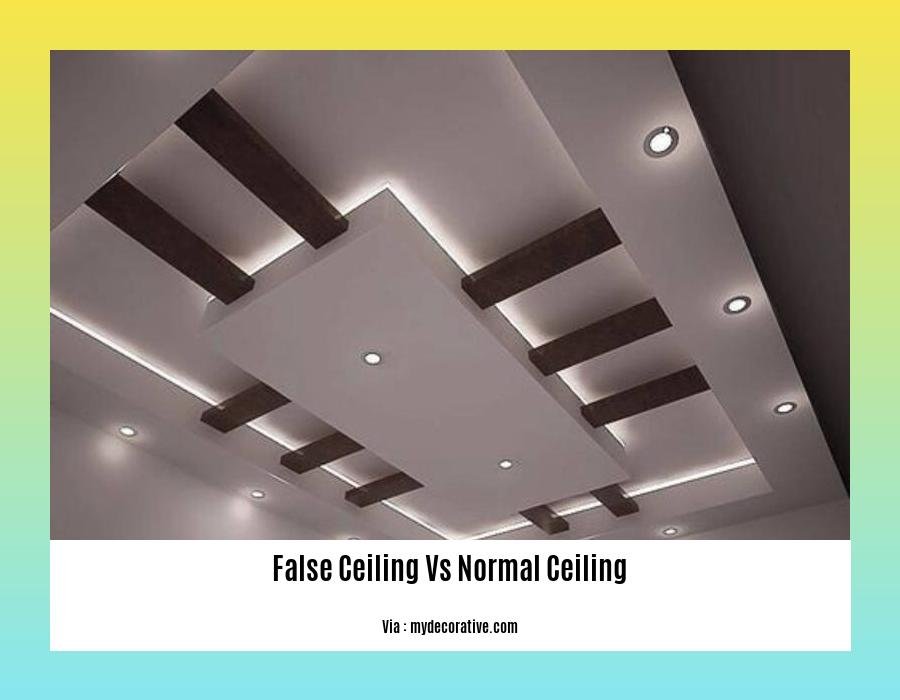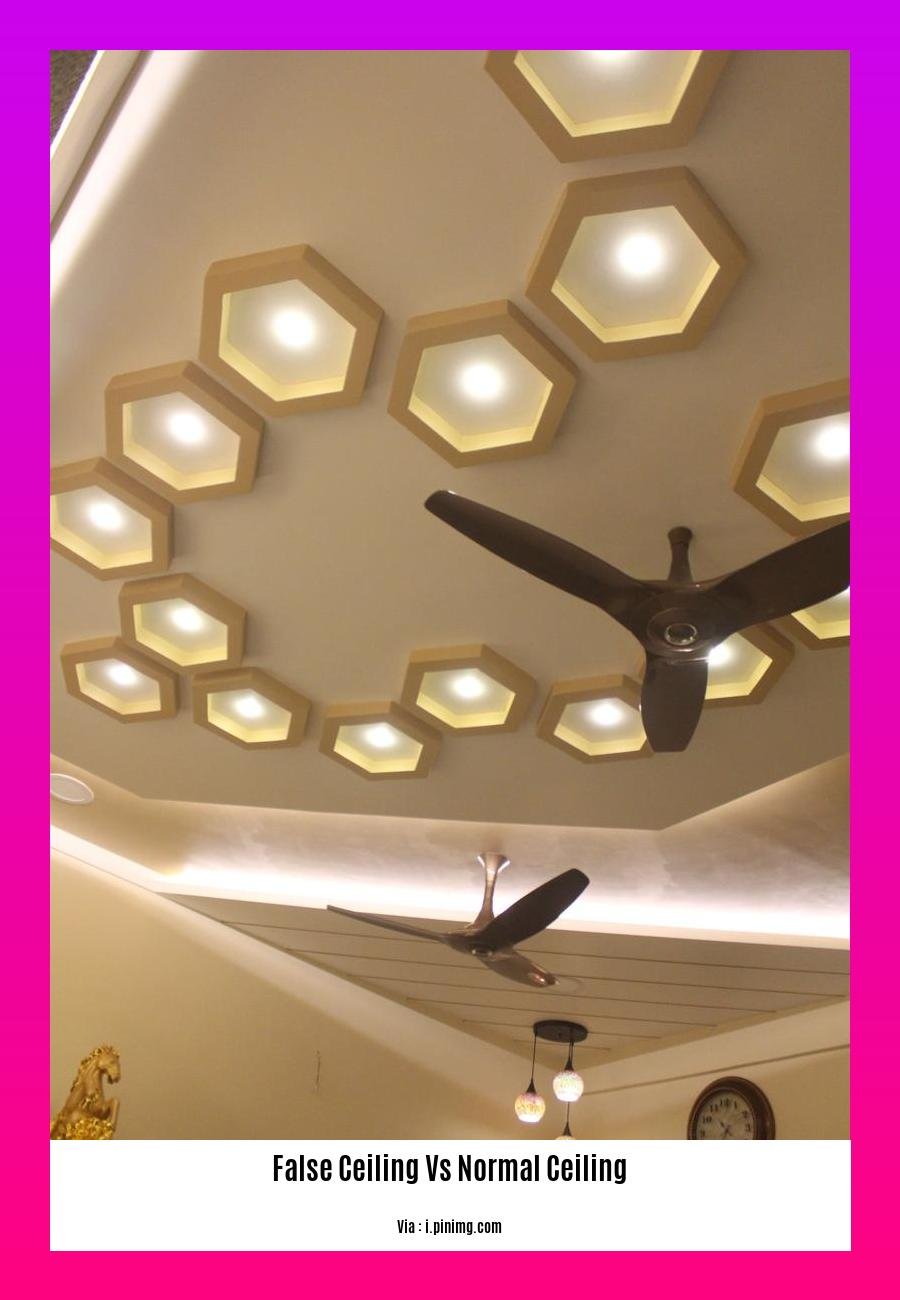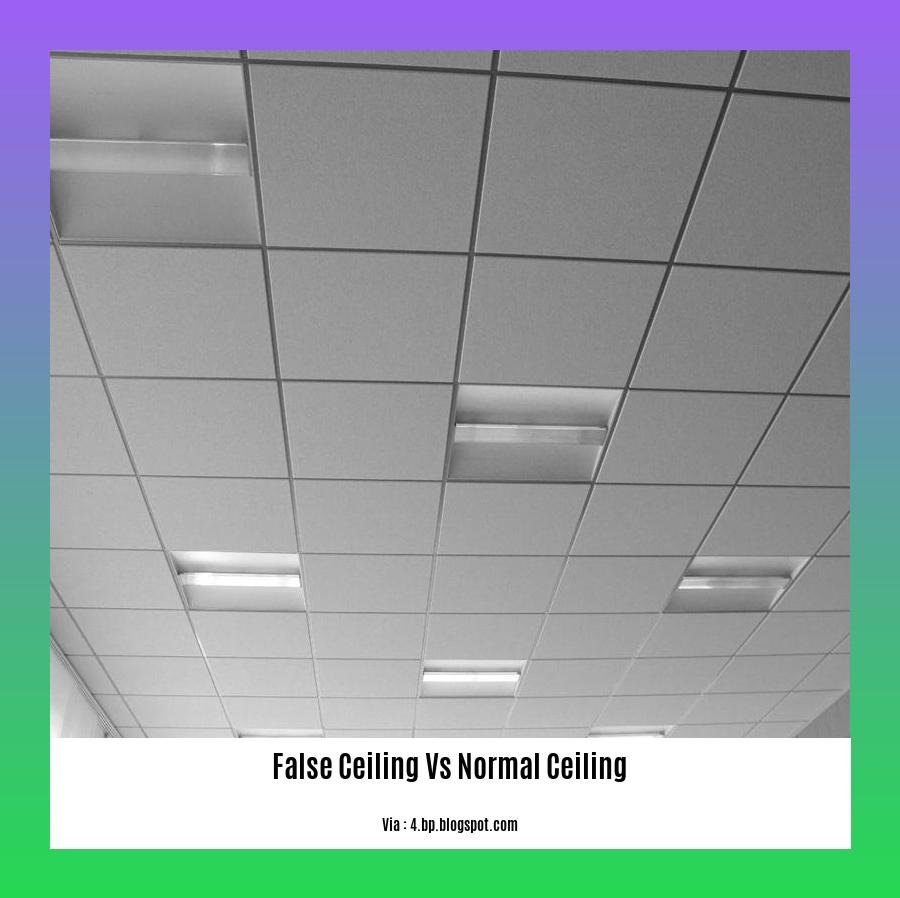Embark on a journey to demystify the realm of ceiling options as we unveil the intricacies of False Ceiling vs Normal Ceiling in [- False Ceiling vs Normal Ceiling: Unveiling the Differences and Guiding Your Choice]. Delve into a comprehensive analysis of construction techniques, material marvels, and design strategies that will empower you to make informed decisions. Unlock the secrets to creating spaces that harmonize functionality and aesthetics, striking a delicate balance between form and function. Let’s embark on this enlightening odyssey of elevated ceiling choices.
Key Takeaways:
-
False ceilings offer design versatility and concealment of structural elements.
-
Sound-absorbing materials in false ceilings can improve acoustics.
-
False ceilings can contribute to energy efficiency by providing insulation.
-
Integration of recessed lighting allows for enhanced lighting effects in a space.
-
Cost-effectiveness and easy access for maintenance make false ceilings a practical choice.
-
Reduced height, potential for decreased natural light, dust accumulation, and limited structural strength are drawbacks of false ceilings.
-
Fire safety concerns necessitate the selection of fire-resistant materials for false ceilings.
False Ceiling vs Normal Ceiling: Unveiling the Differences and Guiding Your Choice

In the realm of interior design, ceilings play a significant role in determining the aesthetics and functionality of a space. When it comes to choosing between a false ceiling vs normal ceiling, various factors come into play.
What’s the Difference?
A false ceiling, also known as a suspended ceiling or drop ceiling, involves installing a secondary ceiling layer below the main structural ceiling. This creates a gap between the two, allowing for flexibility in design and concealing utilities like pipes and electrical wiring. On the other hand, a normal ceiling, also referred to as a traditional ceiling, is a single solid ceiling attached directly to the roof structure.
Advantages and Disadvantages
Both false ceilings and normal ceilings have their own set of pros and cons:
False Ceiling:
Pros:
– Offers a wide range of design options, including different materials, colors, and lighting effects.
– Conceals unsightly elements like pipes and wires, providing a clean and polished look.
– Improves acoustics by absorbing sound and reducing reverberation.
– Easy access to utilities for maintenance and repairs.
– Can contribute to energy efficiency by providing insulation and regulating indoor temperatures.
Cons:
– Reduces the overall height of a room, which may be a concern in spaces with low ceilings.
– Can block natural light if not designed properly, making a room appear darker.
– Requires regular maintenance to prevent dust and debris accumulation.
– May have reduced structural strength compared to traditional ceilings, especially in older buildings.
Normal Ceiling:
Pros:
– Provides a solid and stable ceiling structure.
– Offers a classic and timeless look that blends well with various interior styles.
– No reduction in room height, making it suitable for spaces with low ceilings.
– Generally requires less maintenance compared to false ceilings.
– May be more cost-effective than false ceilings in some cases.
Cons:
– Limited design options and customization possibilities.
– Concealing utilities and wiring can be challenging, resulting in a cluttered look.
– May not offer the same level of sound absorption as false ceilings.
– Access to utilities for maintenance and repairs may be limited.
Ultimately, the choice between a false ceiling vs normal ceiling depends on your specific requirements, preferences, and budget. Consider factors like the room’s height, natural light, desired aesthetics, acoustic needs, and maintenance considerations.
Worried about the impact of LED strip lights on your eyesight? Click here to learn the truth.
Planning to build a bunk bed? Discover the standard bunk bed dimensions in centimeters to ensure a perfect fit.
Searching for durable and stylish chairs for commercial use? Explore our wide selection to meet your business needs.
Suffering from knee pain? Find relief with our specially designed chairs for knee pain that provide exceptional comfort and support.
Craving a modern look for your bedroom? Get inspired by these stunning false ceiling designs for bedrooms in India.
Looking for spacious and functional four-bedroom house designs in Kenya? Check out these inspiring and innovative layouts.
Installation and maintenance: understanding the processes and costs associated with each ceiling type

Considering a new ceiling for your home or commercial space? The choice between a false ceiling and a normal ceiling can be tricky. Both have their own unique advantages and disadvantages. Understanding the processes involved in installation and maintenance can help you make an informed decision. Let’s dive in!
Key Takeaways
- False ceilings: Offer design flexibility, conceal utilities, improve acoustics, and provide energy efficiency, but can reduce room height, block natural light, and require regular maintenance.
- Normal ceilings: Simple and classic, provide no reduction in room height, require less maintenance, but offer limited design options, challenges in concealing utilities, and reduced sound absorption.
- Installation: False ceilings require building a frame and installing panels, while normal ceilings are directly attached to the roof structure.
- Maintenance: False ceilings need periodic cleaning, repainting or replacement of panels, while normal ceilings typically require minor repairs like patching holes or cracks.
1. Installation:
- False ceiling:
- Pros:
- Conceals wires, pipes, and ductwork.
- Can improve soundproofing and insulation.
- Offers flexibility in design and lighting.
-
Cons:
- Requires professional installation.
- Can be more expensive than normal ceilings.
- Reduces room height.
-
Normal ceiling:
- Pros:
- Easy to install and maintain.
- Less expensive than false ceilings.
- Does not reduce room height.
- Cons:
- Limited design options.
- Difficult to conceal utilities.
- Reduced soundproofing and insulation.
2. Maintenance:
- False ceiling:
- Pros:
- Easy to access and repair hidden utilities.
- Panels can be replaced individually.
- Can be painted or redecorated easily.
-
Cons:
- Requires regular cleaning to prevent dust and dirt accumulation.
- Panels may need to be replaced over time due to wear and tear.
-
Normal ceiling:
- Pros:
- Generally low-maintenance.
- Minor repairs like patching holes or cracks are easy to do.
- Cons:
- Difficult to access hidden utilities for repair or maintenance.
- Repainting requires more effort due to the larger surface area.
Conclusion:
Ultimately, the choice between a false ceiling and a normal ceiling depends on your specific needs, preferences, and budget. Consider the pros and cons, installation and maintenance requirements, and the overall look you’re aiming for. Both types of ceilings can enhance the aesthetics and functionality of your space, so take your time and make an informed decision.
Relevant URL Sources:
- Factors to Consider When Choosing Between a False Ceiling and a Normal Ceiling
- False Ceiling vs Normal Ceiling – Which One is Right For You?
False Ceilings vs Normal Ceilings: Expert Insights and Practical Considerations
Key Takeaways:
- False ceilings and normal ceilings have different functions and applications, with false ceilings being a secondary ceiling installed below the main structural ceiling and normal ceilings being the primary ceiling directly attached to the roof.
- False ceilings offer benefits like concealing utilities, improving acoustics, and providing insulation, while normal ceilings offer a classic look, no room height reduction, and low maintenance.
Exploring False Ceilings: Aesthetics and Functionality
False ceilings, also called drop ceilings or suspended ceilings, have become a popular choice in modern architecture for their versatility and practicality. They comprise a secondary ceiling layer installed beneath the main structural ceiling, with a variety of materials and design options to cater to diverse aesthetic preferences. Their main advantage lies in their ability to hide unsightly elements like electrical wiring, pipes, and ducts, creating a clean and polished look. Additionally, false ceilings offer improved acoustics by absorbing sound and reducing noise, making them ideal for spaces like offices, auditoriums, and studios.
Delving into Normal Ceilings: Simplicity and Classic Charm
Normal ceilings, on the other hand, are the traditional type of ceiling directly attached to the roof without any secondary layer. Their primary benefit is the classic and timeless appearance they provide, seamlessly blending into the overall design of a space. They do not reduce room height like false ceilings, allowing for a more spacious feel. Additionally, they require less maintenance as there are no additional layers or components to worry about. Normal ceilings are a cost-effective option suitable for spaces where simplicity, durability, and ease of maintenance are prioritized.
Comparative Analysis: Unveiling the Differences
When making the choice between false ceilings and normal ceilings, it’s essential to consider several factors, including room height, natural light, desired aesthetics, acoustic needs, maintenance requirements, and budget. False ceilings may reduce room height, so they may not be suitable for spaces with low ceilings. Natural light may be blocked in areas where false ceilings are installed, making it essential to consider the placement of windows and lighting fixtures. The desired aesthetics of the space play a crucial role in the decision-making process, as false ceilings offer a wide range of design possibilities compared to normal ceilings. Acoustic needs should also be taken into account, as false ceilings can effectively absorb sound and reduce noise. Lastly, the maintenance requirements and budget should be considered, as false ceilings may require more regular cleaning and maintenance than normal ceilings.
Navigating Installation: A Step-by-Step Guide
Installing a false ceiling involves several steps:
- Planning and Preparation: Measure the area to determine the amount of materials needed, including ceiling panels, suspension system components, and insulation.
- Installing the Suspension System: Secure the metal channels or wooden battens to the ceiling joists using screws or nails.
- Placing Insulation: Cut insulation panels to fit between the suspension system members for improved thermal and acoustic insulation.
- Installing Ceiling Panels: Start from a corner and install the first ceiling panel using screws or clips, ensuring proper alignment and tight joints. Continue installing panels row by row.
- Finishing Touches: Apply sealant around the edges of the ceiling panels for a clean and professional finish.
In conclusion, choosing between false ceilings and normal ceilings depends on the specific requirements of the space and the desired aesthetic. False ceilings offer a multitude of advantages in terms of design flexibility, utility concealment, acoustic enhancement, and insulation, but they may reduce room height and require more maintenance. Normal ceilings provide a classic look, minimal maintenance, and no reduction in room height but may offer limited design options and acoustic performance. Weighing these factors carefully will enable you to make an informed decision that suits your space and preferences.
Citations:
– What Is A False Ceiling | Storables
– False Ceilings VS. Traditional Ceilings: Unraveling The Ultimate …
Making an informed choice: factors to consider when selecting the right ceiling for your needs
Do you often find yourself torn between choosing a false ceiling or a normal ceiling for your space? Each option offers unique advantages and considerations. Let’s delve into the intricate world of ceiling options, exploring their key differences and the factors that will guide you toward the perfect fit for your needs.
Key Takeaways:
- False ceilings, also known as suspended ceilings, are secondary layers installed below the main ceiling, while normal ceilings are attached directly to the roof structure.
- Selecting the right ceiling depends on several key factors, including room height, desired aesthetics, acoustic requirements, lighting preferences, budget, and maintenance needs.
- False ceilings offer design flexibility, ease of concealing utilities, improved acoustics, and increased energy efficiency but can reduce room height and require regular maintenance.
- Normal ceilings provide a classic look, require less maintenance, have no reduction in room height, and allow easier access to utilities but may have limited design options and reduced soundproofing.
- Carefully weigh each factor and consider seeking professional advice to make an informed decision that aligns with your specific requirements and preferences.
Aesthetics: Bringing Beauty Overhead
Want to spruce up your space and add a touch of personal style? A false ceiling lets you play with colors, textures, and designs, transforming a plain ceiling into a dynamic feature. On the other hand, normal ceilings offer a more traditional and minimalist look, allowing other elements of your décor to shine.
Functionality: Beyond Aesthetics
The primary role of a ceiling is not just to look good. It also has a crucial functional role to play. False ceilings provide excellent soundproofing, enhancing acoustic comfort and reducing noise pollution. Their concealed spaces allow for easy installation of recessed lighting and HVAC systems, keeping your wires and ducts out of sight. Normal ceilings, on the other hand, offer easier access to utilities and maintenance, making them a popular choice for commercial spaces.
Maintenance and Upkeep: Keeping Your Ceiling Looking Its Best
Every homeowner wants a ceiling that stays beautiful and functional for years to come. False ceilings require regular cleaning to prevent dust accumulation, occasional repainting to keep the finish fresh, and periodic inspection for signs of moisture damage or structural issues. Normal ceilings, on the other hand, are generally easier to maintain, requiring only occasional cleaning and repainting when needed.
Cost Considerations: Striking a Balance
Budget plays a crucial role in any home improvement decision. False ceilings tend to be more expensive than normal ceilings due to the materials and labor involved in their installation. However, they can save you money in the long run by reducing energy consumption and improving acoustic comfort, potentially lowering your utility bills.
Weighing Your Options: Making the Right Choice
Choosing between a false ceiling and a normal ceiling is not a one-size-fits-all decision. It depends on your unique requirements, preferences, and budget. If versatility, design flexibility, and soundproofing are high on your list, a false ceiling might be the perfect choice. If you prefer a classic look, easier maintenance, and straightforward installation, a normal ceiling might be your go-to option.
Citation:
- Storables: What Is A False Ceiling | Storables
- GTI: False Ceilings VS. Traditional Ceilings: Unraveling The Ultimate Choice…
FAQ
Q1: What is the primary difference between a false ceiling and a normal ceiling?
Q2: Which type of ceiling, false or normal, is better for concealing unsightly elements like pipes and wires?
Q3: In terms of acoustics, which ceiling type offers better sound absorption and noise reduction?
Q4: Which ceiling type is generally more cost-effective, false or normal, considering both installation and maintenance?
Q5: Which ceiling type is more suitable for integrating recessed lighting and fixtures?
- Stovetop Backsplash Ideas: Stylish Protection for Your Kitchen Cooking Zone - December 23, 2025
- Embossed Backsplash Tile Kitchen: Add Texture And Style - December 22, 2025
- Ceramic Tile Backsplash Ideas for Your Kitchen Remodel - December 21, 2025










